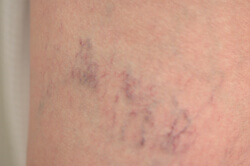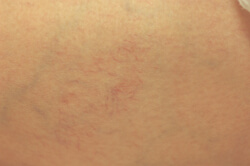Having embarrassing spider veins on your legs can really affect your life. They may keep you from wearing the clothes you love or from going to the gym or pool. Many patients like you suffer with spider veins. And no matter what kind of physical shape you’re in, genetics and previous pregnancies are often the main culprits for their development.
If you’re thinking about getting rid of your spider veins, then you’ve probably read about laser and injection treatment options and wonder which one might be best for you? We’ve had many of our own patients come in asking the same question, so we wanted to share our insights with you.

 Both injections and lasers can work well for the removal of leg veins. However, they are not always interchangeable, because they target different sized blood vessels. Remember that spider veins happen when deeper and larger leg veins develop faulty one-way valves. This allows the blood to “back up”, which fills the smaller veins near the skin’s surface making them visible. Most people with spider veins have a mix of both larger and smaller leg veins.
Both injections and lasers can work well for the removal of leg veins. However, they are not always interchangeable, because they target different sized blood vessels. Remember that spider veins happen when deeper and larger leg veins develop faulty one-way valves. This allows the blood to “back up”, which fills the smaller veins near the skin’s surface making them visible. Most people with spider veins have a mix of both larger and smaller leg veins.
Laser therapy involves the use of heat energy to target the hemoglobin in the blood within the spider vein. This heats up the entire vein, coagulating and clotting the blood inside it, collapsing the vessel walls and seals it off. Once it’s no longer a functioning vein, the body breaks it down and removes it.
Sclerotherapy is a bit different. It involves the direct injection of a detergent-like solution into the unwanted vein. This solution damages the inner lining of the vessel wall by dehydrating it. This causes the entire blood vessel to harden or “sclerose” which makes it unusable by the body. It too eventually is broken down and removed.
We’d also like to mention that sclerotherapy carries the potential for a couple of unwanted side effects that laser treatment does not. First, when red blood cells from the treated vessels leak out and into the surrounding skin, it can cause “staining”. Hemosiderin staining is a brownish discoloration that persists in the treated areas as residual iron from the blood cells remains (sometimes for years) after the rest of the blood cell and vessel has broken down and been removed. While there are different laser treatments that can help remove it, many people feel that staining after sclerotherapy looks worse and is harder to get rid of than the spider veins themselves.
Another phenomenon we’ve seen after sclerotherapy is matting. Matting is the appearance of a “mat” of new, fine blood vessels just next to the treated area. This happens as the blood can no longer get through the hardened veins and looks to make its way into other, surrounding blood vessels.
This brings us (finally!) to an answer to the title question of this page: it depends! Some people will need both treatments. Here at Celibre Medical, we generally use sclerotherapy for larger or “feeder” veins (called reticular vessels) and laser for matting or fine veins that we can’t inject into easily. An experienced sclerotherapy provider who understands the ins and outs of treatment well will usually perform and recommend both treatments at their practice.
If you’re not sure if laser, sclerotherapy or both are right for you, we can help! Our experienced providers can evaluate you and tailor a treatment plan that best fits your legs to get them looking great in no time.

